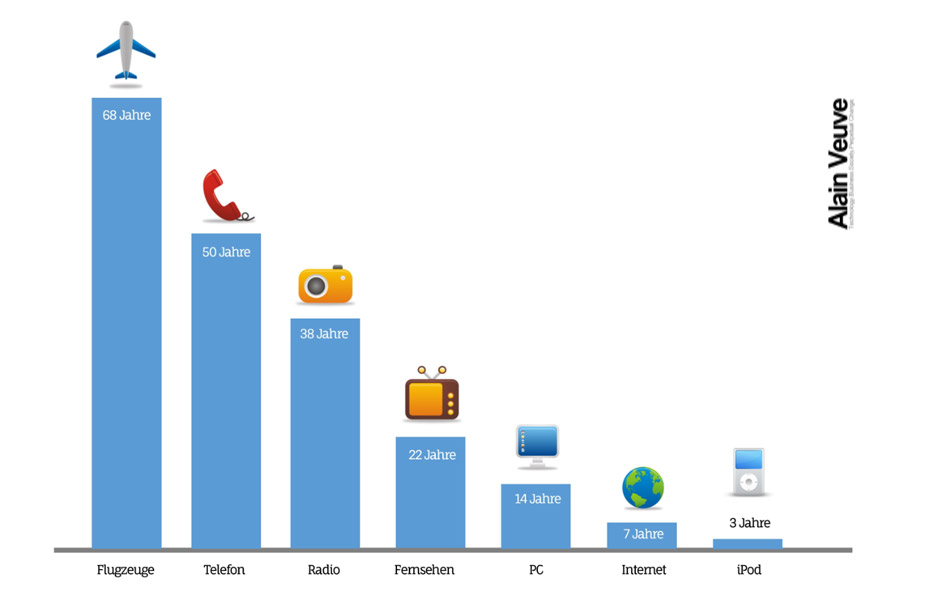Get in touch
I've already written a lot about how technological progress will significantly change the course of the upcoming years. There are two issues that we all must deal with in this context. On the one hand, we need to be concerned about how a society handles rapid change without radically breaking with the currently prevailing values. On the other hand, we must ask ourselves how companies need to be positioned in order to profit from this change. In the following article I would like to touch upon a few issues regarding these questions.
It's gradually becoming clear that companies must react to a change situation as well as a changed environment in increasingly shorter cycles. The formula for this logic is trivial: Whereas, in the 1960s, it was enough to continue progressing with a perspective of 20 years, these 20 years are the current equivalent of five (reference value). The key factor is how quickly the mass market adapts a technology. The following image shows a few examples of how long a technology needed to be accepted into the mainstream:

How, then, must a company be structured in order to survive in this environment? It is obvious that the current rigid models with large, inflexible hierarchies and set processes are hardly capable of handling this transition. Adjusting such an organization would require such a large degree of effort and so much communication that the company could no longer be run profitably. In addition, it would simply be too slow.
The conclusion is that we need a new corporate format. In my opinion, the only template that meets these requirements is the Agile company. Please don't confuse “Agile” in this context with project methodology. Of course it is only natural that an Agile company also uses Agile project methods, but these two items need not necessarily go together – aside from the term itself.
The Agile business model is not yet so established that there would be a lot of literature about the topic. However, businessdictionary.com offers a comprehensive definition:
While this article was being written I was painstakingly looking for companies that were organized along these lines. And, as is sometimes the case, one fails to see the forest for the trees. In this case I was no exception, as I didn't realize until very late that we here at AOE are structured exactly like this. It isn't as if we don't talk about these topics internally, but it already feels so normal that I don't pay particular attention to this circumstance in my everyday life. I would therefore like to use our company to illustrate which competencies can be found in an Agile business and what works – as well as what doesn't.
At AOE there are no hierarchies. Instead we have teams. A team is a group of self-organized colleagues that provides a service. This service can be a customer project, marketing, office keeping, HR or any other relevant issue. Whenever something needs to be accomplished, a group of people concerns itself with the matter. Whenever possible, the employee should be able to move from one team to the next. This means that employees organize themselves, take responsibility for the performance of the team and define their own work. For instance, vacation isn't approved centrally but colleagues discuss this with their team and are absent when they and the team decide that it is appropriate. In this way, decisions are made within a small unit according to each situation, administrative overhead, for example, vacation planning is limited to logging the days in which one is absent.
Regarding customer projects, teams are relatively established and have worked together for some time in order to design and develop complex omni-channel platforms, as is usually the case at AOE. However, teams can also be created on an ad-hoc basis, whenever a need for such a team is identified. Most of the time a few people realize that action is needed, from which side-teams are created that temporarily concern themselves with a particular topic. This process is institutionalized in our “Open Friday”, which will be described later in this article.
If you hear the word “management” you automatically think about Porsches, three-piece suits, flights in business class, always on the road, endless meetings, etc. For the longer part of my career I lived a very strong top-down management model and, to be honest, was only moderately successful. To demand much, to be strict and consistent yet fair are all attributes of a patriarchal leadership model. During training members of management are taught that one needs personal and professional authority in order to lead effectively. Honestly, I think that this is nonsense. That time has definitely passed.
Let me give you an example. If a corporate leader recruits personnel according to the paradigm of professional authority, more often than not employees are hired that have less professional skills then their supervisor. Thus, the organization isn't maximizing its potential. Isn't it much better if a corporate leader hires employees who are professionally more skilled than he or she and then learns from those colleagues during their common journey? In order for that to work, one has to let employees “just do it”, even if the leader isn't always in a position to judge whether something is correct from a technical perspective.
A large degree of trust in employees is required in order to act in this manner. If problems arise, one is well advised to approach them with as little prejudice as possible. It simply means that one has to invest a great deal into the recruiting process, to foster an employee once the hiring decision has been made, to remove obstacles and to have the confidence and trust that the employee will develop to his or her potential. I see every day with us that this works.
Officially, our management comprises four people out of 200+ employees. The official management's role is to provide as optimal a working environment as possible. At AOE this is sometimes lived until reaching the economic pain threshold. Among others, this includes numerous benefits for employees; from Thai massage and in-office lunch, to automatic pay raises and all-expenses paid ski trips for the entire company, etc. It's important to note that our business model is not inexhaustible, continuously generating profits. On the contrary, as all other IT service providers we are trying to maintain our position in the global market. Specifically, this means that these benefits are provided at the expense of net profits. In other words, entrepreneurs must not only view servant leadership as a leadership model one must also support the principle from an ideological perspective. In the long term, and I say this also with regard to a sensationally low staff turnover, I am convinced that servant leadership is economically worthwhile, too.

I view servant leadership as an integral element of an Agile company. I don't know how else one would be able to lead a rapidly-changing business without permanently overtaxing management.
Traditionally, it is the task of management to further develop the company. This means that, if possible, the executives develop a strategy, sometimes together with external consultants; this strategy is then implemented top-down. All of you surely have heard employees in various departments talking about how management has decided something and everyone thinks the decision is absurd. But, one cannot claim that all strategic considerations are wrong or, even worse, absurd – quite the contrary. However, since they are developed at the very top of the corporate ladder they are usually comprehended only with difficulty by the staff, at least at the beginning. For this larger companies need a tailor-made program to implement the strategy. With regards to corporate culture this is unspeakable situation. This costs an enormous amount of money and is hardly efficient. To this effect Agile companies have a community solution. At AOE we call this internal event “Open Friday” – I quote from our intranet:
We organize Open Friday according to Open Space Technology. These sessions are crucial for improvement processes and new teams that implement new requirements. Changes in the company are initiated here and find a natural path to implementation.
Our business model is different from the one used by a traditional agency in many regards. To provide a detailed view is beyond the scope of this article. For this reason, I would only like to state: Growth creates more growth at AOE. And this growth is a very real challenge. Take for example our German headquarters: In 2012 (when I came to AOE), 51 colleagues were permanently employed in Wiesbaden; today, that number is 150 (May 2015).
Such growth – please note, organic – is a big challenge when only considering just the infrastructure. Culturally, it is a giant leap forward.
This growth is also a result of venturing into new business sectors and working with much larger clients. We didn't just simply complete x-times more of the same projects while serving the same customers, but rather we completed completely different projects with completely different customers. That the team kept its spirit during this journey (even though very little remained as it was) and was able to meet all of the many new demands (which it will continue to do), is for me the proof-of-concept that the model of the Agile business is ideally suited to cope with rapid change.
When I spoke about us as an Agile organization to a representative of a large company two years ago, he replied: “That is all well and good, but let us see what happens when you are 200 people.” Et voilà, we are now 200+, it still works and there is no end in sight.
The aforementioned points could leave the impression that everything is running without a hitch or problem and that the Agile business model is a kind of savior. Or course it isn't and yes, we have issues, some of the quite massive. Things that don't work, projects that run off-course, plans that need revising. All is not gold that glitters, as little with us as, say, IBM.
Here are three points:
For me, the Agile business model is clearly the model of the future. It is perfectly suited to anticipate rapid change and to participate in this change without losing sight of the economic aspects. It generates products and services that can be introduced in the market more quickly while also being better suited to fulfill the needs of the customer. And it places the employee into the center of economic activity in a humane way. If we take a look at societal developments of the past 20 years we can observe that people want exactly that: more freedom, more leisure time, more self-actualization, more flexibility. For this they are willing to give back: more personal responsibility, more quality, more passion and identification as well as more flexibility. For me, this looks like a mutual win-win situation. Or, rather, less alienation between economic and social life.
Now, of course, knowledge work is perfect for the Agile business model. But make no mistake on this issue, there are also manufacturing companies that are already living the Agile enterprise model. I'll present two or three examples in an upcoming article.